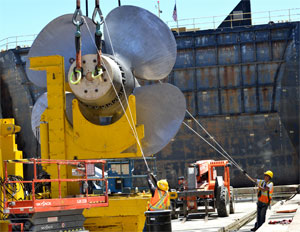The U.S. Coast Guard will receive $675 million to fund construction of the nation’s first polar security cutter, or heavy icebreaker, an appropriation that proponents say is long overdue as the only operational ship of its type in the U.S. fleet continues to deteriorate.
In a spending package passed in February, Congress allocated $655 million for the lead vessel in the program, with an additional $20 million to purchase long-lead-time materials for a second cutter. The House of Representatives had canceled funding for the heavy icebreaker program last summer to help fund President Trump’s border wall project, according to the U.S. Naval Institute (USNI).
Barry Lane, a Coast Guard spokesman, said an additional $300 million in previously allocated Navy advance procurement funding will go toward the design and construction of the initial polar security cutter. The Coast Guard’s proposed budget for fiscal year 2020 identifies another $35 million for management and production of the ships, he added.
The Coast Guard has just one operational heavy icebreaker, the 43-year-old Polar Star. The ship has experienced a litany of mechanical problems on its recent voyages, including power outages, a failed shaft seal and a fire in February on its annual resupply mission to Antarctica’s McMurdo Station.
The new ship funded by Congress “will be capable of operating in extreme polar conditions where continued surface presence is essential to national security, maritime domain awareness, freedom of navigation, and protecting national sovereignty,” Lane said.
In its request for design and construction proposals, the Coast Guard established 2023 as the target year for delivery of the first ship. The Coast Guard and Navy are evaluating the proposals and plan to award a contract this year, Lane said. He could not provide a specific date for when an announcement would be made.
According to Jim Dolbow, editor of The Coast Guardsman’s Manual and former member of the USNI editorial board, the need for new icebreakers has existed for well over a decade. The recent funding provided by Congress “gets us on the path of building three more heavy icebreakers and three more medium icebreakers,” he said.
Six new icebreakers is the minimum number needed, Dolbow said, noting that Russia currently has a larger icebreaker fleet than the U.S. According to The National Interest magazine, Russia has two operational heavy icebreakers, with four more being refitted.
“We have a lot of natural minerals and resources underneath the Arctic Ocean that are U.S. territory, and we need to protect our sovereignty,” Dolbow said, referencing the U.S. exclusive economic zone (EEZ).
The United Nations has designated EEZs for Arctic nations, including the U.S. The framework gives countries control over resources up to 200 miles off their coasts, according to the Council on Foreign Relations.
Icebreakers help keep trading lanes open, and new polar security cutters could help the U.S. Navy increase its presence in the Arctic, Dolbow said.
Lane said polar security cutters “will be capable of supporting all identified mission areas, capable of operating in both the Arctic and Antarctic regions and across a spectrum of environmental conditions.” But the ships will hold particular significance for national security with respect to the Arctic, Dolbow said.
“There’s a lot more traffic up there now than in years past, so we just need to have a presence,” he said.

